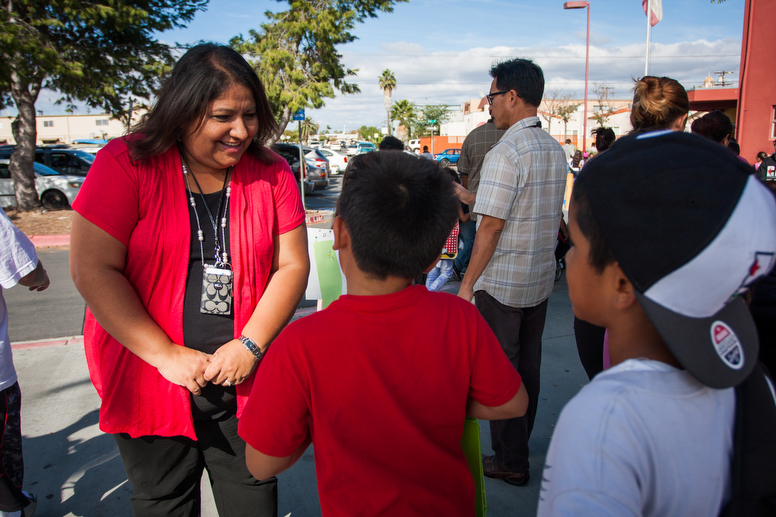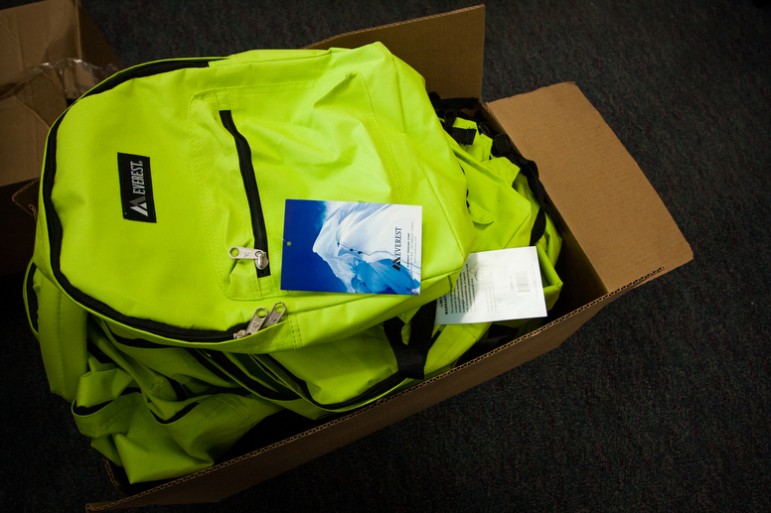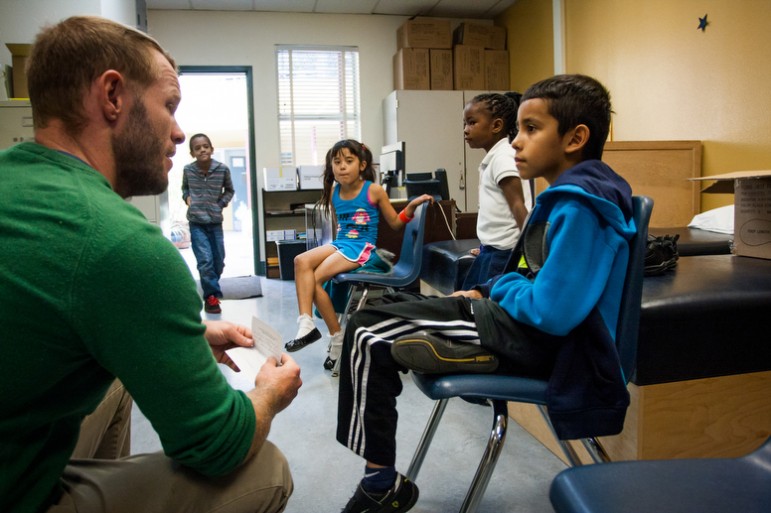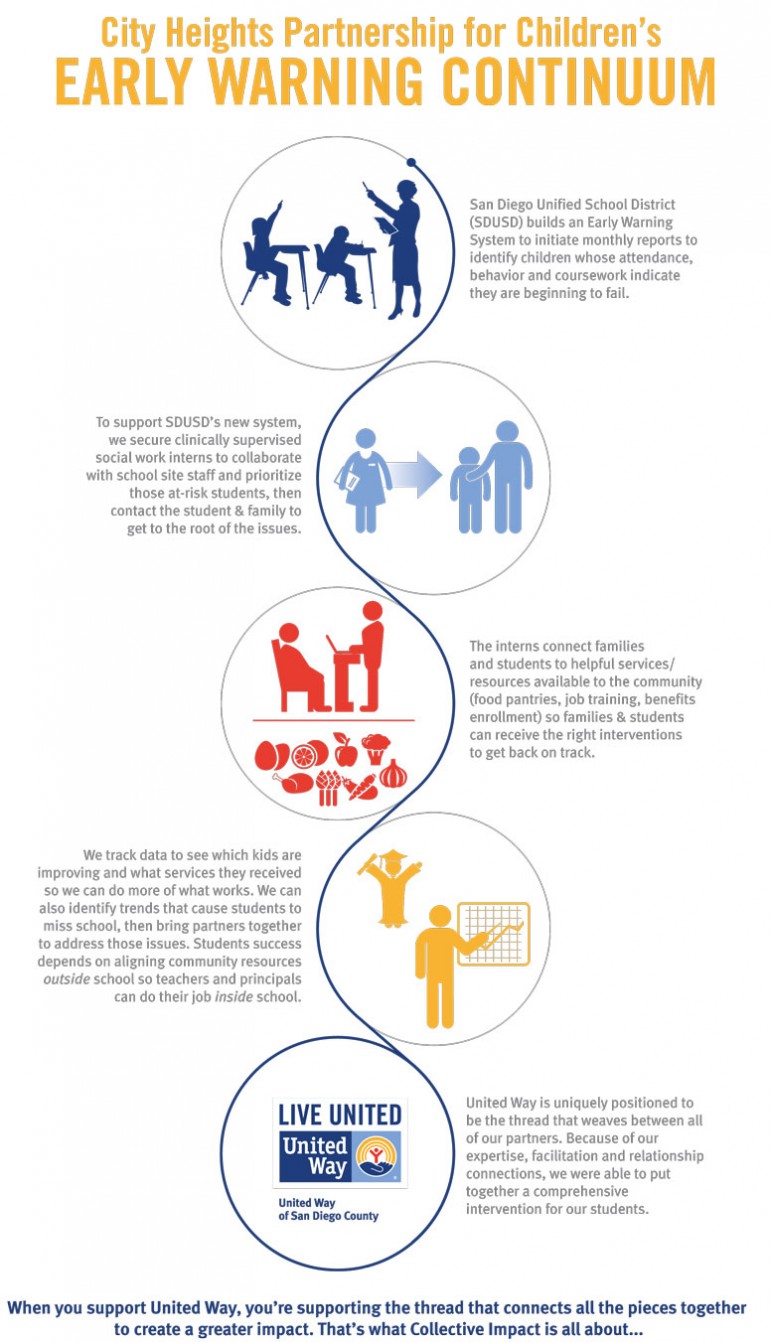 Central Elementary principal Liz Duvall says goodbye to students as they leave school for the day. | Photo By Dustin Michelson
Central Elementary principal Liz Duvall says goodbye to students as they leave school for the day. | Photo By Dustin Michelson
When Liz Duvall, principal of Central Elementary school, looks at a list students who are chronically late or absent from school, she notices a concerning trend: Her youngest students, kindergartners and first graders, make up the bulk of those who miss class most often.
Even with the list, however, there’s no way for Duvall to understand all the barriers keeping students out.
She can’t see that a 7-year-old’s mom works the third shift, so getting to school means a trolley ride, a bus transfer and a 15-minute walk. Or that another 6-year-old needs to wait for a ride from grandma, and by the time she corrals him and his two older brothers, they’re inevitably late for school.
Knowing those things requires someone to invest the time to look into it. But under a new pilot program being rolled out at Central and two other campuses, that’s exactly what would happen.
As part of the program, James Kenyon, a student from Point Loma Nazarene University, completes a social work internship at Central by helping school staff dig into chronic absenteeism.
Earlier this school year, Duvall, Kenyon and Central staff created a list of students who missed school most often. That team treats each student’s situation as a case to be unpacked, meeting weekly to talk about how the student is doing and identifying which need immediate intervention.
That could mean something as simple as a phone call or finding students rides to school – or something more complex, like referring the family to an agency that could help them land housing.
But even with the extra help from Kenyon, there are more students in need than there are resources. The team at Central is currently targeting 18 kids and keeping an eye on 62 others. The objective is simple: Improve attendance by the end of the school year.
Central is one of three schools taking part in a collaboration between San Diego Unified, local universities and the City Heights Partnership for Children (which is anchored by the United Way of San Diego County). The pilot program takes college students working toward degrees in social work and embeds them at Central Elementary, Adams Elementary and Hoover High, where they operate as social work interns.
Interns at Central and Adams are focusing primarily on absenteeism. Those at Hoover will work with chronically absent students, those with poor grades (lower than a 2.0 GPA) and kids who’ve been suspended.
The pilot will last through the school year. After that, United Way and San Diego Unified will take stock of what went well, what could be improved and what could be expanded or replicated in other parts of the district.
Why start with three schools in City Heights? Tia Anzellotti, director of partnerships at United Way, said the neighborhood is one of the most youth-dense, impoverished and linguistically diverse in the county.
 A box of new backpacks sits with other donated items in the Central Elementary office, ready to be doled out to needy kids. | Photo By Dustin Michelson
A box of new backpacks sits with other donated items in the Central Elementary office, ready to be doled out to needy kids. | Photo By Dustin Michelson
We thought if we could get it to work here, we could get it to work anywhere,” said Anzellotti.
The pilot project is meant to enhance the district’s new early warning system, which monitors student data and flags students who are having problems with attendance, behavior or academics. These three indicators, research has shown, are among the most reliable predictors of future success.
Here’s how the United Way sees the pilot project fitting into the district’s work:
To understand how these pieces fit together, let’s take a step back and look at the system.
The Early Warning System
San Diego Unified is testing the premise that it can prevent students from falling through the cracks if it can identify early on who’s slipping.
While educators have widely viewed data as a weapon through recent years of high-stakes testing – attaching penalties to schools or teachers who didn’t raise students’ scores on standardized tests – a growing number of states are now returning to statistics as a way to head off student dropouts.
San Diego Unified is putting finishing touches on a system that it will roll out in the coming months.
A few details are yet to be ironed out, but it’ll look something like this: On an ongoing basis, data on attendance, academics and behavior will be added to an online information system. If students are chronically absent (two or more per month), tardy at least six times a month, falling below a 2.0 GPA or have been suspended, their names will trigger notifications that are then sent to schools.
Ideally, each school will designate a point-person who’ll keep a list of targeted students and bring staff together to prioritize needs – much in the same way Central is doing.
To understand why this is important, consider a recently published report detailing how many students are on track to meet 2016 graduation requirements.
It paints a stark picture: 41 percent of high school juniors – about 3,000 students – hadn’t passed the required college-prep classes they needed to be considered on-track. A disproportionate number of those falling short were black or Latino students, English learners and those with special needs.
The district said the numbers were only a snapshot, not a projection of how many students would eventually graduate. There’s still time for students to make up credits through online classes, summer school or extended school days.
But it begs a deeper question: How did so many students arrive at this point?
It’s easy to focus on graduation rates, but they’re actually the end result of a story that starts much earlier. In fact, a study done in Baltimore – where a similar system has been implemented – found that as early as grade school, students are establishing patterns that predict their chances of graduating.
The study looked at four indicators in a group of sixth-graders: students who failed English or math, those who had been suspended three or more days, students who were older compared with the rest of their class (suggesting they’d been held back because they failed courses) and those chronically absent from school.
About 70 percent of sixth graders who didn’t meet those thresholds went on to graduate within a year of their expected graduation date. Of the students registering one of the warning signs, only half graduated on time. For those hitting two warning signs, it was 26 percent. It got worse from there.
San Diego Unified hasn’t yet done that type of analysis, so it’s uncertain how these trajectories play out locally. But Ron Rode, director of the district’s office of research and development, said this is something he’s working on with research partners at UCSD.
Researchers elsewhere have warned that such a system should be used as a diagnostic tool, not a crystal ball to peer into a student’s destiny. If teachers see certain students as future dropouts, for example, they may treat them as such. If students envision themselves that way, problems might snowball.
Despite those risks, the early warning system will provide principals and counselors the most comprehensive picture yet of where students are falling short.
The biggest challenge will be to find the staff members who can follow up with students to figure out what’s going on.
Filling in Gaps
Central Elementary has long been something of a darling in San Diego Unified, an example of the kind of urban school that can achieve success despite the fact that 96 percent of its students live at or below the poverty line.
This is Cindy Marten’s old stomping grounds, where she rose to local fame even before she moved from principal to superintendent. Her legacy looms large here. Now it’s Duvall’s – part CEO, part mother hen – to oversee.
Take a trip to the school, and it’s easy to see why this school gets attention. School leaders, it seems, have thought of everything. A gaggle of preschoolers walk hand-in-hand across the playground. A daycare, open to kids of district staff, has plenty of toys for toddlers to climb on. An on-site health clinic, stocked with donated medicine, serves sick kids.
Jared Yore, a full-time nurse at the school, is a popular guy. Kids sign out of class to see him, or spend their recess in Nurse Jared’s office complaining of invisible cuts and bruises.
“We see a lot of headaches and tummy aches here,” said Yore. “You’d be surprised what two cups of water and 10 minutes of lying down can accomplish.”
 Central Elementary’s nurse, Jared Yore, speaks with students. | Photo By Dustin Michelson
Central Elementary’s nurse, Jared Yore, speaks with students. | Photo By Dustin Michelson
He jokes, but he knows that many of the stomach pains have to do with the fact that kids are not eating much at home. One black-haired boy in his office gets an energy bar on this day. The boy says he forgot to eat dinner the night before.
The nurse’s office is one example of where the school’s responsibility and a student’s home life intersect. It also underscores the fact that even with all the supports available at Central, even a good school has its limits.
Tad Parzen, former executive director of City Heights Partnership for Children, told me last year that one blind spot we have as a community is that we expect schools to be all things to all students, but don’t fund them to meet those demands. Then we get mad at them when they don’t deliver.
But here, at these three schools in City Heights, we see a nonprofit picking up where the school district leaves off, coming together to beat back poverty’s impact on schools.

